Community Safety and Community Relations
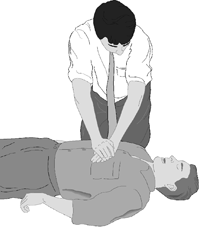 CPR and First Aid
CPR and First Aid
The Salt River Fire Department offers CPR and First Aid courses to members of the Community and to the various Community enterprises. The courses offered are certified through the American Health and Safety Institute (ASHI).
For more information please call (480) 362-7290 to place your name on the next roster.
Child Passenger Safety Program
Through education, training, enforcement, outreach and legislation, NHTSA seeks to ensure that all children ages 0-16 are properly restrained in the correct restraint system for their age and size every time they travel in a motor vehicle.
While great progress has been achieved in recent years in preventing child occupant deaths and injuries, and increasing the correct use of child safety seats, booster seats and safety belts – thanks in no small measure to the tireless dedication of NHTSA and its many partners in the child passenger safety community – more work needs to be done to protect child occupants who remain at heightened risk.
The Salt River Fire Department offers certified technicians for car seats, contact (480) 362-7290 to make an appointment.
Child Safety Seat
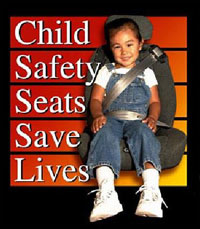 One Minute Checklist
One Minute Checklist
Using a safety seat correctly makes a big difference. A child safety seat may not protect your child in a crash if it isn’t used correctly and installed in the vehicle properly. So take a minute and take the National Highway Traffic Safety Administration’s One Minute Check!
Child Car Seat Safety
Before we start:
- All children ages 12 and under should ride restrained in the back seat.
- Never place a child safety seat in the front seat where there is a passenger air bag.
Now you will need to:
- Read the instructions that came with the car seat.
- Read the vehicle owner’s manual – the seatbelt and car seat installation section.
Infants: Birth to age one and at least 20 pounds should ride in the back seat in a rear-facing safety seat.
- Harness straps should be at or below the infant’s shoulders.
- The harness straps should be snug. This is your baby’s seatbelt, snug will keep the infant safe!
- The harness chest clip must be at the infant’s armpit level. This clip will position the harness straps to stay over the baby’s shoulders, before a crash.
- If your baby weighs more than 20 pounds before the first birthday, a convertible safety seat that goes to 30-35 pounds rear facing will be needed.
- Riding backward is the safest thing for your child.
Toddlers: Children over one year of age and at least 20 pounds may ride forward facing in the back seat. Children should ride in a safety seat with a full harness until they weigh about 40 pounds. This is the safest way for a child.
- Harness straps should be at or above the child’s shoulders.
- Harness straps should be threaded through the top slots of most safety seats. Check the instructions.
- Harness straps are snug. Remember – baby’s seatbelt!
- Harness chest clip should be at the child’s armpit level. It positions the harness straps on the child’s shoulders, so in a crash the child stays in the safety seat.
Big Kids: Children between 40-80 pounds should ride in the back seat in a belt-positioning booster seat. A booster seat uses the adult lap and shoulder belt. Booster seats should be used until the adult lap and shoulder belt fit the child properly.
- Belt-positioning boosters can only be used with both lap and shoulder belts across the child. The shoulder belt should be snug against the child’s chest, crossing at the collarbone. The lap belt should lay low across the child’s upper thighs.
- Boosters are used in that “between” stage of being too big for a “baby-seat” and not quite big enough for the adult seat belt.
- Booster seats should be used until the child can sit with his/her back against the vehicle seat back cushion, knees bent over the seat cushion edge and his/her feet are on the floor. Approximately: 4’9″.
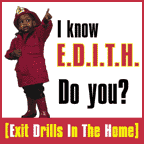 Exit Drills in the Home (E.D.I.T.H.)
Exit Drills in the Home (E.D.I.T.H.)
Unlike Hollywood and television, real fire is dark – the smoke is thick and black; you can’t see through it and the toxic gases in the smoke can be disorienting. However, if you have practiced crawling below smoke level, feeling your way along the walls and counting doors to your exit, you will know exactly what to do and be better prepared to exit safely in a real fire.
All members of your household should participate in the process of developing your escape plan, even young children.
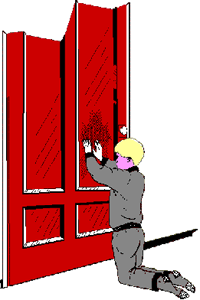 When making your home escape plan …
When making your home escape plan …
- Take a walk through your home and locate two escape routes from each room, making sure each exit is accessible. Having two accessible ways out of each room greatly improves your chances of escaping a fire in your home.
- Check for windows that could be painted shut, make sure they open. Open and check below the window. Is there anything outside the window that would hamper your escape or injure you if you have to use the window for an exit? If so, now is the time to make corrections.
- If you have bars on your bedroom windows, they must open from the inside of the room. If not, they must be made operable so they can. Bars can and will trap you inside of your own home.
- If your bedrooms are located on the second floor, do you have escape ladders for each bedroom?
- Check for doors blocked by furniture or storage.
- Establish a meeting place a safe distance from your home.
- If you have very young, very old, or disabled occupants in the home, try to locate their bedroom on the ground floor and designate someone to help them in an emergency.
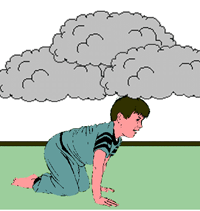 Remember …
Remember …
- STOP … before opening a door. Feel the door. While remaining on your knees reach up and feel the door as high as you can reach without standing up. Feel the door knob, around the edges and bottom of the door. If you feel heat don’t open that door, use your alternative exit.
- If you encounter smoke on your way out, use your alternative exit. If you must escape through smoke, stay down and crawl under the smoke where the air is clearer and cooler.
- If your clothing catches fire, Stop, Drop and Roll (covering your face with your hands) to extinguish the flames.
- Once outside, never go back into a burning building for any reason. Call 9-1-1 from a neighbor’s phone.
Practice …
Practicing your escape before fire strikes will enable you to get out faster with less panic. If you know your escape route by heart you will be able to get out quickly even if you’ve been exposed to disorienting smoke and gases.

